

Compact Muon Solenoid
LHC, CERN
| CMS-EXO-17-025 ; CERN-EP-2018-326 | ||
| Search for contact interactions and large extra dimensions in the dilepton mass spectra from proton-proton collisions at $\sqrt{s} = $ 13 TeV | ||
| CMS Collaboration | ||
| 26 December 2018 | ||
| JHEP 04 (2019) 114 | ||
| Abstract: A search for nonresonant excesses in the invariant mass spectra of electron and muon pairs is presented. The analysis is based on data from proton-proton collisions at a center-of-mass energy of 13 TeV recorded by the CMS experiment in 2016, corresponding to a total integrated luminosity of 36 fb$^{-1}$. No significant deviation from the standard model is observed. Limits are set at 95% confidence level on energy scales for two general classes of nonresonant models. For a class of fermion contact interaction models, lower limits ranging from 20 to 32 TeV are set on the characteristic compositeness scale $\Lambda$. For the Arkani-Hamed, Dimopoulos, and Dvali model of large extra dimensions, the first results in the dilepton final state at 13 TeV are reported, and values of the ultraviolet cutoff parameter $\Lambda_{\text{T}}$ below 6.9 TeV are excluded. A combination with recent CMS diphoton results improves this exclusion to $\Lambda_{\text{T}}$ below 7.7 TeV, providing the most sensitive limits to date in nonhadronic final states. | ||
| Links: e-print arXiv:1812.10443 [hep-ex] (PDF) ; CDS record ; inSPIRE record ; HepData record ; CADI line (restricted) ; | ||
| Figures | |
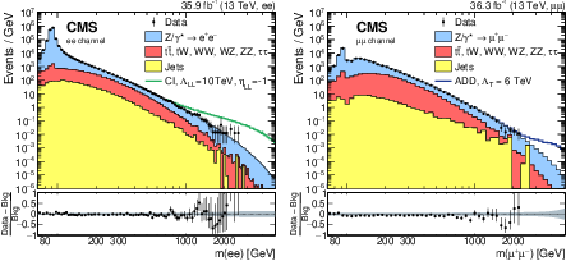
png pdf |
Figure 1:
Electron (left) and muon (right) pair invariant mass spectra for the combined barrel-barrel and barrel-endcap event categories. Example model predictions are given for CI (left) and ADD (right). The lower panel shows the relative difference between the data and predicted background. The gray band gives the fractional uncertainty (statistical and systematic) in the prediction. |
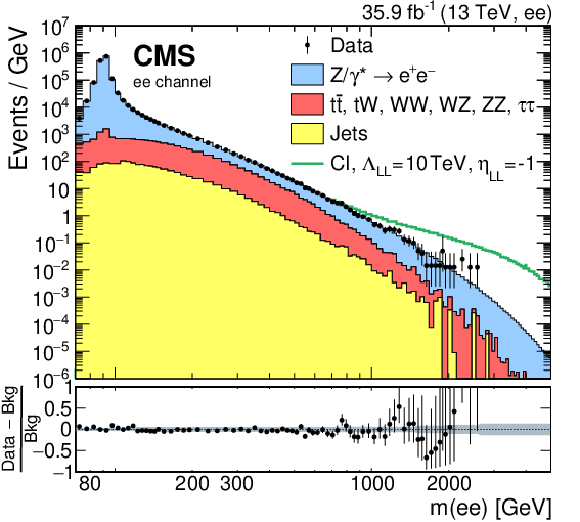
png pdf |
Figure 1-a:
Electron pair invariant mass spectrum for the combined barrel-barrel and barrel-endcap event categories. Example model predictions are given for CI. The lower panel shows the relative difference between the data and predicted background. The gray band gives the fractional uncertainty (statistical and systematic) in the prediction. |
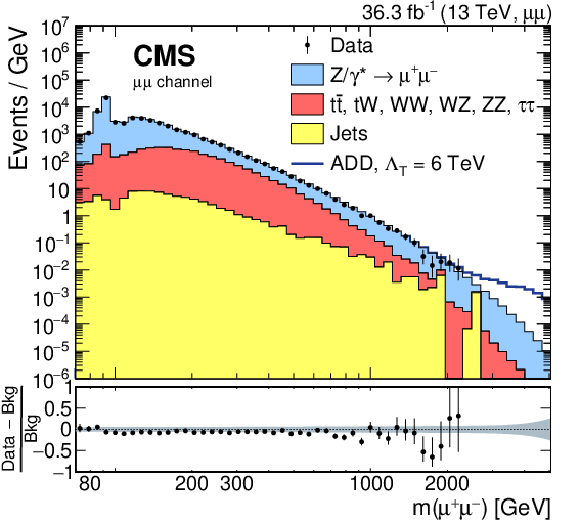
png pdf |
Figure 1-b:
Muon pair invariant mass spectrum for the combined barrel-barrel and barrel-endcap event categories. Example model predictions are given for ADD. The lower panel shows the relative difference between the data and predicted background. The gray band gives the fractional uncertainty (statistical and systematic) in the prediction. |

png pdf |
Figure 2:
Dilepton exclusion limits at 95% CL on the CI scale ($\Lambda $) for the six CI models considered for the electron (left) and muon (right) channels. The limits are obtained for $ {m_{\ell \ell}} > $ 400 GeV in the case of constructive (destructive) interference. |
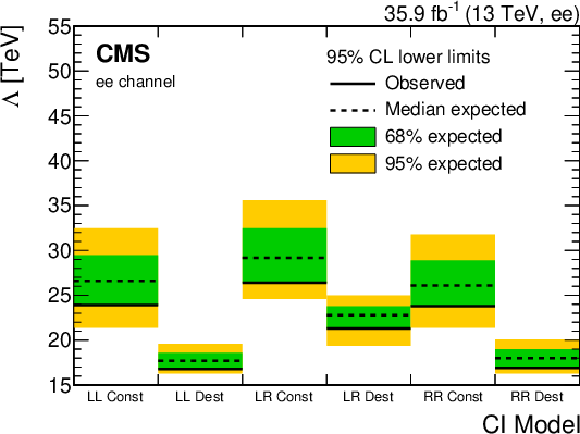
png pdf root |
Figure 2-a:
Dilepton exclusion limits at 95% CL on the CI scale ($\Lambda $) for the six CI models considered for the electron channel. The limits are obtained for $ {m_{\ell \ell}} > $ 400 GeV in the case of constructive (destructive) interference. |

png pdf root |
Figure 2-b:
Dilepton exclusion limits at 95% CL on the CI scale ($\Lambda $) for the six CI models considered for the muon channel. The limits are obtained for $ {m_{\ell \ell}} > $ 400 GeV in the case of constructive (destructive) interference. |

png pdf |
Figure 3:
Combined dilepton 95% CL exclusion limits on the cross section for the left-left constructive CI model (left), and on the CI scale ($\Lambda $) for the six different CI models considered (right). The red curve in the left plot shows the theoretical cross section as a function of $\Lambda $. The limits are obtained for $ {m_{\ell \ell}} > $ 400 GeV in the case of constructive (destructive) interference. |

png pdf root |
Figure 3-a:
Combined dilepton 95% CL exclusion limits on the cross section for the left-left constructive CI model. The red curve shows the theoretical cross section as a function of $\Lambda $. The limits are obtained for $ {m_{\ell \ell}} > $ 400 GeV in the case of constructive (destructive) interference. |

png pdf root |
Figure 3-b:
Combined dilepton 95% CL exclusion limits on the CI scale ($\Lambda $) for the six different CI models considered. The limits are obtained for $ {m_{\ell \ell}} > $ 400 GeV in the case of constructive (destructive) interference. |

png pdf |
Figure 4:
Exclusion limits at 95% CL on the UV cutoff for the electron (left) and muon (right) channels with $ {m_{\ell \ell}} > $ 1.8 TeV in the GRW, Hewett, and HLZ conventions for the ADD model. Signal model cross sections are calculated up to leading order and a correction factor of 1.3 is applied. The results are compared to the previous combined result from CMS [8]. |

png pdf |
Figure 4-a:
Exclusion limits at 95% CL on the UV cutoff for the electron channel with $ {m_{\ell \ell}} > $ 1.8 TeV in the GRW, Hewett, and HLZ conventions for the ADD model. Signal model cross sections are calculated up to leading order and a correction factor of 1.3 is applied. The results are compared to the previous combined result from CMS [8]. |
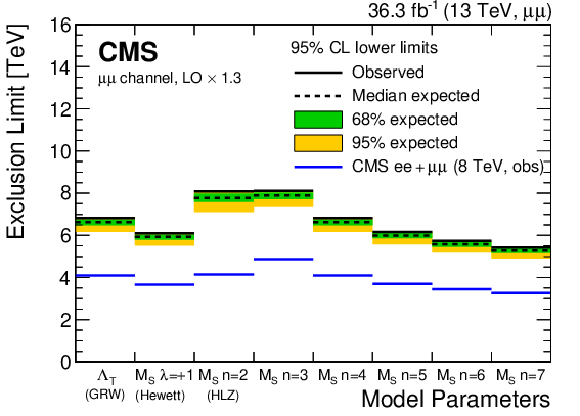
png pdf |
Figure 4-b:
Exclusion limits at 95% CL on the UV cutoff for the muon channel with $ {m_{\ell \ell}} > $ 1.8 TeV in the GRW, Hewett, and HLZ conventions for the ADD model. Signal model cross sections are calculated up to leading order and a correction factor of 1.3 is applied. The results are compared to the previous combined result from CMS [8]. |

png pdf |
Figure 5:
Combined dilepton 95% CL exclusion limit on the cross section in the GRW convention (left) and on the UV cutoff for all parameter conventions (right) with $ {m_{\ell \ell}} > $ 1.8 TeV for the ADD model. The curves labeled ADD in the left plot show the theoretical signal cross section calculated by PYTHIA, as a function of the cutoff parameter ${\Lambda _{\mathrm {T}}}$, and signal contributions with $ {m_{\ell \ell}} > {\Lambda _{\mathrm {T}}} $ are set to 0. Signal model cross sections are calculated up to leading order and, where indicated by the appropriate label, a correction factor of 1.3 is applied. The results are compared to previous ones from CMS [8]. |

png pdf |
Figure 5-a:
Combined dilepton 95% CL exclusion limit on the cross section in the GRW convention, with $ {m_{\ell \ell}} > $ 1.8 TeV for the ADD model. The curves labeled ADD show the theoretical signal cross section calculated by PYTHIA, as a function of the cutoff parameter ${\Lambda _{\mathrm {T}}}$, and signal contributions with $ {m_{\ell \ell}} > {\Lambda _{\mathrm {T}}} $ are set to 0. Signal model cross sections are calculated up to leading order and, where indicated by the appropriate label, a correction factor of 1.3 is applied. |
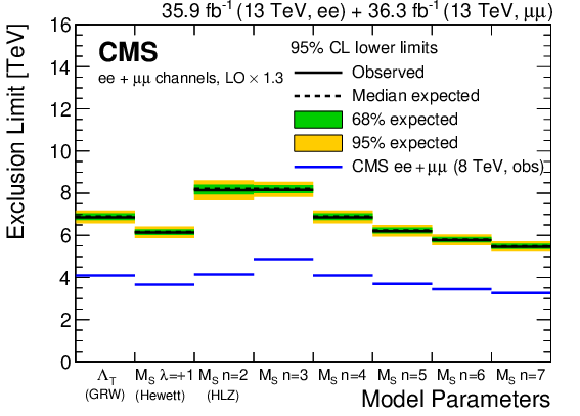
png pdf |
Figure 5-b:
Combined dilepton 95% CL exclusion limit on the UV cutoff for all parameter conventions, with $ {m_{\ell \ell}} > $ 1.8 TeV for the ADD model. Signal model cross sections are calculated up to leading order and, where indicated by the appropriate label, a correction factor of 1.3 is applied. The results are compared to previous ones from CMS [8]. |

png pdf |
Figure 6:
Individual and combined dilepton (this analysis) and diphoton [10] 95% CL expected (left) and observed (right) exclusion limits as a summary of all parameter conventions for the ADD model. Signal model cross sections are calculated up to leading order. The dilepton limits from the $\sqrt {s} = $ 8 TeV measurement [8] are also shown. |
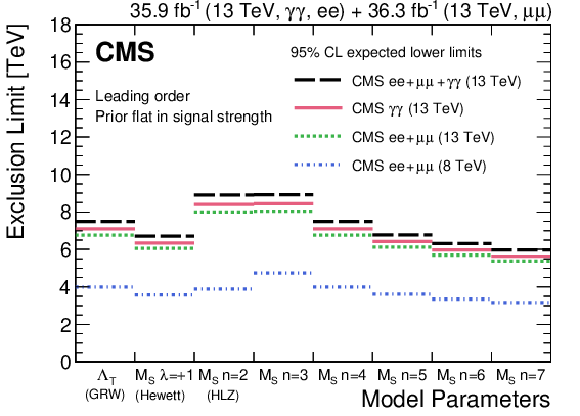
png pdf |
Figure 6-a:
Individual and combined dilepton (this analysis) and diphoton [10] 95% CL expected exclusion limits as a summary of all parameter conventions for the ADD model. Signal model cross sections are calculated up to leading order. The dilepton limits from the $\sqrt {s} = $ 8 TeV measurement [8] are also shown. |
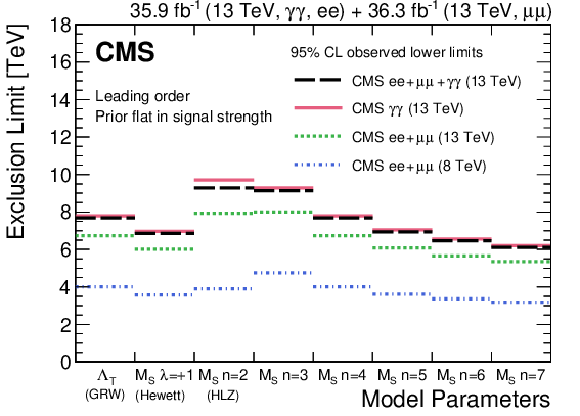
png pdf |
Figure 6-b:
Individual and combined dilepton (this analysis) and diphoton [10] 95% CL observed exclusion limits as a summary of all parameter conventions for the ADD model. Signal model cross sections are calculated up to leading order. The dilepton limits from the $\sqrt {s} = $ 8 TeV measurement [8] are also shown. |
| Tables | |

png pdf |
Table 1:
Systematic uncertainties in the predicted SM yields for the electron and the muon channels, for two dilepton mass thresholds. Where noted, uncertainties are provided separately for events where both leptons are in the barrel region (BB), or where at least one of the leptons is in the endcap region (BE). Uncertainties that are mass-dependent affect both the event yield and the shape of the invariant mass distribution. The systematic uncertainties in the signal yields are largely the same as for the background, with a few exceptions as discussed in the text. |

png pdf |
Table 2:
Exclusion limits at 95% CL for the electron and muon channels, their combination, and the combination with the diphoton [10] analysis, in multiple parameter conventions of the ADD model. Signal model cross sections are calculated up to leading order and, where indicated by the appropriate label, a correction factor of 1.3 is applied. For each of the model parameters, the first value is the observed limit followed by the expected limit in parentheses. |
| Summary |
|
A search for nonresonant excesses in the invariant mass spectra of electron and muon pairs has been presented. The data set recorded with the CMS detector during 2016 is analyzed, corresponding to an integrated luminosity of {35.9} ({36.3}) fb$^{-1}$ for the electron (muon) channel. No significant deviations from standard model expectations are observed. A contact interaction (CI) model, taking into account both constructive and destructive interference scenarios, has been used for interpreting the experimental measurements. The 95% confidence level exclusion limits on the compositeness scale range from $\Lambda_{\text{LL}} > $ 20 TeV for the destructive case to $\Lambda_{\text{RR}} > $ 32 TeV for the constructive one, for the left-left and the right-right helicity currents, respectively. For the Arkani-Hamed-Dimopoulos-Dvali (ADD) model of large extra dimensions, values of the ultraviolet cutoff parameter $\Lambda_{\text{T}}$ (in the Giudice-Rattazzi-Wells, GRW, convention) below 6.9 TeV have been excluded at the 95% confidence level. This corresponds to an exclusion on the string scale $M_{\text{S}}$ below 6.1 TeV in the Hewett convention; in the Han-Lykken-Zhang (HLZ) convention, lower limits are set on $M_{\text{S}}$ that range from 5.5 to 8.2 TeV, depending on the number of extra dimensions. When combined with the results from the latest CMS diphoton analysis [10], these limits improve to 7.7 TeV (GRW), 6.9 TeV (Hewett), and the range 6.1 to 9.3 TeV (HLZ), respectively. The results presented here for the CI and ADD models improve on previous CMS results at $\sqrt{s} = $ 8 TeV in the dilepton final state [8]. The CI limits on $\Lambda$ are compatible with the dilepton results reported by the ATLAS Collaboration [12,13]. However, an exact comparison is not possible because the ATLAS limits are based on priors for $\Lambda$, whereas the limits reported here are based on a prior that is flat in cross section. For the ADD model, the results reported here are the first measurements at $\sqrt{s} = $ 13 TeV in the dilepton final state. The combination with the CMS diphoton analysis yields the most sensitive results in nonhadronic final states to date. |
| References | ||||
| 1 | E. Eichten, I. Hinchliffe, K. Lane, and C. Quigg | Supercollider physics | Rev. Mod. Phys. 56 (1984) 579 | |
| 2 | N. Arkani-Hamed, S. Dimopoulos, and G. Dvali | The hierarchy problem and new dimensions at a millimeter | PLB 429 (1998) 263 | hep-ph/9803315 |
| 3 | E. Eichten, K. Lane, and M. Peskin | New tests for quark and lepton substructure | PRL 50 (1983) 811 | |
| 4 | Particle Data Group, M. Tanabashi et al. | Review of particle physics | PRD 98 (2018) 030001 | |
| 5 | G. F. Giudice, R. Rattazzi, and J. D. Wells | Quantum gravity and extra dimensions at high-energy colliders | NPB 544 (1999) 3 | hep-ph/9811291 |
| 6 | J. L. Hewett | Indirect collider signals for extra dimensions | PRL 82 (1999) 4765 | hep-ph/9811356 |
| 7 | T. Han, J. D. Lykken, and R. Zhang | Kaluza--Klein states from large extra dimensions | PRD 59 (1999) 105006 | hep-ph/9811350 |
| 8 | CMS Collaboration | Search for physics beyond the standard model in dilepton mass spectra in proton-proton collisions at $ \sqrt{s}= $ 8 ~TeV | JHEP 04 (2015) 025 | CMS-EXO-12-061 1412.6302 |
| 9 | CMS Collaboration | Search for high-mass resonances in dilepton final states in proton-proton collisions at $ \sqrt{s}= $ 13 ~TeV | JHEP 06 (2018) 120 | CMS-EXO-16-047 1803.06292 |
| 10 | CMS Collaboration | Search for physics beyond the standard model in high-mass diphoton events from proton-proton collisions at $ \sqrt{s}= $ 13 ~TeV | PRD 98 (2018) 092001 | CMS-EXO-17-017 1809.00327 |
| 11 | CMS Collaboration | Search for new physics in dijet angular distributions using proton-proton collisions at $ \sqrt{s}= $ 13 ~TeV and constraints on dark matter and other models | EPJC 78 (2018) 789 | CMS-EXO-16-046 1803.08030 |
| 12 | ATLAS Collaboration | Search for contact interactions and large extra dimensions in the dilepton channel using proton-proton collisions at $ \sqrt{s}= $ 8 ~TeV with the ATLAS detector | EPJC 74 (2014) 3134 | 1407.2410 |
| 13 | ATLAS Collaboration | Search for new high-mass phenomena in the dilepton final state using 36 fb$ ^{-1} $ of proton-proton collision data at $ \sqrt{s}= $ 13 ~TeV with the ATLAS detector | JHEP 10 (2017) 182 | 1707.02424 |
| 14 | CMS Collaboration | The CMS experiment at the CERN LHC | JINST 3 (2008) S08004 | CMS-00-001 |
| 15 | CMS Collaboration | The CMS trigger system | JINST 12 (2017) P01020 | CMS-TRG-12-001 1609.02366 |
| 16 | CMS Collaboration | Search for narrow resonances in dilepton mass spectra in proton-proton collisions at $ \sqrt{s}= $ 13 ~TeV and combination with 8 TeV data | PLB 768 (2017) 57 | CMS-EXO-15-005 1609.05391 |
| 17 | CMS Collaboration | Performance of electron reconstruction and selection with the CMS detector in proton-proton collisions at $ \sqrt{s}= $ 8 ~TeV | JINST 10 (2015) P06005 | CMS-EGM-13-001 1502.02701 |
| 18 | CMS Collaboration | Performance of the CMS muon detector and muon reconstruction with proton-proton collisions at $ \sqrt{s}= $ 13 ~TeV | JINST 13 (2018) P06015 | CMS-MUO-16-001 1804.04528 |
| 19 | P. Nason | A new method for combining NLO QCD with shower Monte Carlo algorithms | JHEP 11 (2004) 040 | hep-ph/0409146 |
| 20 | S. Frixione, P. Nason, and C. Oleari | Matching NLO QCD computations with parton shower simulations: the POWHEG method | JHEP 11 (2007) 070 | 0709.2092 |
| 21 | S. Alioli, P. Nason, C. Oleari, and E. Re | A general framework for implementing NLO calculations in shower Monte Carlo programs: the POWHEG BOX | JHEP 06 (2010) 043 | 1002.2581 |
| 22 | S. Alioli, P. Nason, C. Oleari, and E. Re | NLO vector-boson production matched with shower in POWHEG | JHEP 07 (2008) 060 | 0805.4802 |
| 23 | S. Frixione, P. Nason, and G. Ridolfi | A positive-weight next-to-leading-order Monte Carlo for heavy flavour hadroproduction | JHEP 09 (2007) 126 | 0707.3088 |
| 24 | E. Re | Single-top $ \mathrm{W}\Pqt $-channel production matched with parton showers using the POWHEG method | EPJC 71 (2011) 1547 | 1009.2450 |
| 25 | NNPDF Collaboration | Parton distributions for the LHC Run II | JHEP 04 (2015) 040 | 1410.8849 |
| 26 | T. Sjostrand et al. | An introduction to PYTHIA 8.2 | CPC 191 (2015) 159 | 1410.3012 |
| 27 | Y. Li and F. Petriello | Combining QCD and electroweak corrections to dilepton production in the framework of the FEWZ simulation code | PRD 86 (2012) 094034 | 1208.5967 |
| 28 | M. Botje et al. | The PDF4LHC Working Group Interim Recommendations | 1101.0538 | |
| 29 | S. Alekhin et al. | The PDF4LHC Working Group Interim Report | 1101.0536 | |
| 30 | J. Butterworth et al. | PDF4LHC recommendations for LHC Run II | JPG 43 (2016) 023001 | 1510.03865 |
| 31 | A. Manohar, P. Nason, G. P. Salam, and G. Zanderighi | How bright is the proton? A precise determination of the photon parton distribution function | PRL 117 (2016) 242002 | 1607.04266 |
| 32 | D. Bourilkov | Photon-induced background for dilepton searches and measurements in pp collisions at 13 TeV | 1606.00523 | |
| 33 | D. Bourilkov | Exploring the LHC landscape with dileptons | 1609.08994 | |
| 34 | GEANT4 Collaboration | GEANT4--a simulation toolkit | NIMA 506 (2003) 250 | |
| 35 | M. Czakon and A. Mitov | Top++: A program for the calculation of the top-pair cross-section at hadron colliders | CPC 185 (2014) 2930 | 1112.5675 |
| 36 | N. Kidonakis | Two-loop soft anomalous dimensions for single top quark associated production with a W$ ^{-} $ or H$ ^{-} $ | PRD 82 (2010) 054018 | 1005.4451 |
| 37 | R. Boughezal et al. | Color-singlet production at NNLO in MCFM | EPJC 77 (2016) 7 | 1605.08011 |
| 38 | J. M. Campbell, R. K. Ellis, and W. T. Giele | A multi-threaded version of MCFM | EPJC 75 (2015) 246 | 1503.06182 |
| 39 | J. M. Campbell, R. K. Ellis, and C. Williams | Vector boson pair production at the LHC | JHEP 07 (2011) 018 | 1105.0020 |
| 40 | J. M. Campbell and R. K. Ellis | Update on vector boson pair production at hadron colliders | PRD 60 (1999) 113006 | hep-ph/9905386 |
| 41 | NNPDF Collaboration | Parton distributions with LHC data | NPB 867 (2013) 244 | 1207.1303 |
| 42 | J. Alwall et al. | The automated computation of tree-level and next-to-leading order differential cross sections, and their matching to parton shower simulations | JHEP 07 (2014) 079 | 1405.0301 |
| 43 | T. Ahmed et al. | NNLO QCD corrections to the Drell--Yan cross section in models of TeV-scale gravity | EPJC 77 (2017) 22 | 1606.08454 |
| 44 | CMS Collaboration | CMS luminosity measurements for the 2016 data taking period | CMS-PAS-LUM-17-001 | CMS-PAS-LUM-17-001 |
| 45 | The ATLAS Collaboration, The CMS Collaboration, The LHC Higgs Combination Group | Procedure for the LHC Higgs boson search combination in Summer 2011 | CMS-NOTE-2011-005 | |
| 46 | L. Moneta et al. | The RooStats project | in 13th International Workshop on Advanced Computing and Analysis Techniques in Physics Research ACAT2010 | 1009.1003 |
| 47 | J. Ott | Theta--A framework for template-based modeling and inference | 2010 \url http://www-ekp.physik.uni-karlsruhe.de/\ ott/theta/theta-auto | |

|
Compact Muon Solenoid LHC, CERN |

|

|

|

|

|

|